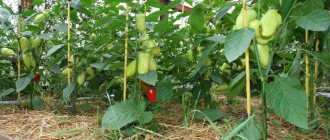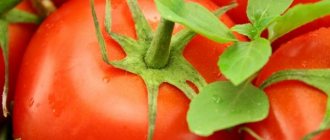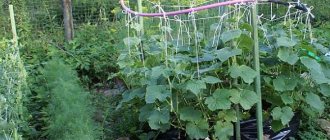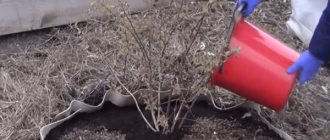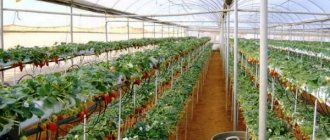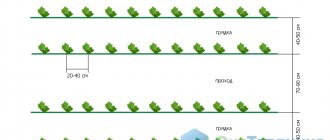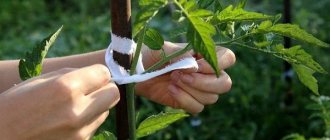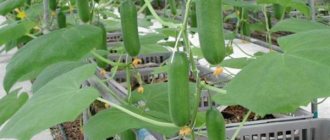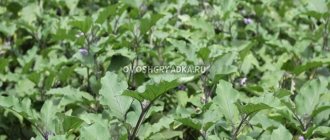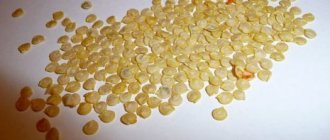What is pinching and why do you pinch tomatoes?
Stepchildren are additional shoots that form in the axils between the main trunk and the leaves growing from it. And pinching is an agrotechnical procedure in vegetable growing aimed at increasing productivity. By removing excess shoots, you can properly form a tomato bush, helping the clusters with ovaries to develop better, thereby increasing the yield of fruits from the bush. The main purpose of the technique is that by removing unnecessary shoots, all the nutrients go towards the development of flower clusters and the formation of ovaries. As a result, the number and size of fruits increases.
If additional shoots are not removed, you will end up with a huge plant with a lot of green tops, and there will be few brushes and set fruits. The number of ovaries is compensated by a decrease in their size, the fruits grow small. In addition, dense plantings are a risk factor for the development of fungal diseases with subsequent plant death. Other varieties may be late in bearing fruit altogether, not reaching their full potential.
Peculiarities
It is important to remember that tomatoes come in different types:
- indeterminate;
- semi-determinate;
- determinant.
Peculiarities
Each of these types has its own characteristics of formation and pinching. You can watch video materials on how to grow tomatoes in a greenhouse.
Indeterminate varieties
These are tomato varieties that have no growth restrictions. Such varieties are usually formed into one stem. This is due to the fact that indeterminate plants tend to form many lateral shoots.
To form a tomato bush into one stem, it is necessary to remove all the stepsons. It is advisable to leave a “stump” about 1 cm high at the site of the removed shoot. This contributes to the slower formation of new shoots. On such a tall plant, as a rule, about 10 flower shoots are left, removing all the rest.
If the size of your greenhouse allows, then you can form such bushes into two stems. (See Dimensions of a polycarbonate greenhouse) To do this, leave the first or second, after which the bush is hilled and mulched. You can leave 4-5 flower clusters on the second stem, making sure to remove all lateral and basal shoots.
Semi-determinate varieties
Tomatoes classified as semi-determinate can grow up to 180cm. If the plants are not planted very densely, then they can be formed into either two or three stems. In tomatoes belonging to semi-determinate varieties, it often happens that after pinching, the main stem stops growing and grows up. Therefore, if semi-determinate varieties predominate in your greenhouse, you should not plant all the plants at once. First make sure that the main stem has not stopped growing.
If the stem is complete, then the bush can be formed into several.
When do tomatoes plant after planting in the ground?
Many people don't know when to start removing extra shoots on their tomatoes. It is impossible to name the exact date, since everyone lives in different climatic conditions. And depending on weather conditions, seedlings are planted at different times. The formation of a plant begins when, after planting the seedlings in a permanent place, it has become stronger and began to grow intensively. This usually happens 1-2 weeks after planting the seedlings in the ground.
When stepsons appear on seedlings, they are removed immediately after planting them in the ground. During this period, the shoots are thin and weak, so the plant will endure the operation less painlessly.
Which method to choose depending on the tomato variety
All tomatoes are divided into 3 varieties - determinate, semi-determinate and indeterminate. Determinate varieties finish development after the formation of 4-5 inflorescences. Semi-determinate ones can stop growing at any time, or they can grow further. Indeterminate tomatoes grow without restrictions.
Indeterminate
They are grown with 1 stem; sometimes, to increase the yield, gardeners grow them with 2 shoots. The formation of 2 stems is used only in large-volume greenhouses; it is permissible to plant seedlings in them at large intervals so that the plants have enough light. The second shoot is grown from the stepson that appears under the first inflorescence; 4-5 inflorescences are left on it, the rest are cut off.
Semi-determinant
It is impossible to know in advance whether tomatoes of these varieties will grow after several brushes. For this reason, they always leave one more (spare) shoot on them. If the main one stops developing, then fruits will form on the reserve one. If after 6-8 brushes the main shoot develops further, then the second shoot can be cut off so that it does not consume nutrients. The strongest stepson should be left as a reserve stem.
If a plant of a certain variety can grow higher than the greenhouse, then one shoot is left on it. The top is pinched a month before harvesting the fruit.
See also Description and characteristics of the tomato variety Budenovka
Superdeterminant
For such varieties, the previously described schemes cannot be used, but their development cannot be “left to chance.” It is necessary to regularly pick off the leaves located under the lower brush. This way you will reduce the load and the crop will ripen faster. Superdeterminate tomatoes form 1-2 stems.
No more than 3 clusters are grown on each stem. If you still leave 3 shoots, then you will receive part of the unripe fruits. Ripening occurs simultaneously and the plant does not have enough strength.
Determinant
Some determinate low varieties do not form at all. But in order to grow many early fruits, the bush needs to be grown with only 1 stem. No more than 4 inflorescences are left on it, the rest are cut off when removing the stepsons. A few leaves above the last cluster are left untouched, but the growing point is tweezed. With this formation, you can get the harvest 2 weeks earlier. Tips for growing determinate tomatoes can be found on the seed packet.
How to properly plant tomatoes
There are general rules that must be followed when removing excess shoots.
- The procedure is carried out throughout the season, preferably 1-2 times a week, then the shoots will not have time to take on more nutrients;
- The optimal length of shoots for removal is 5-7 cm, but not more than 10 cm. Removing larger shoots leads to weakening of the plant and the development of diseases;
- The shoots are not broken out, but pinched or cut off with pruning shears, leaving a stump of 0.5-1 cm, otherwise a new shoot will grow in this place again;
- It is recommended to remove unnecessary shoots early in the morning, preferably on a sunny day, so that the cut (wound) has time to heal during the day. If the weather is cloudy, treat the cut with wood ash to be on the safe side. The ash will disinfect the cut, help it dry faster and prevent the entry of pathogenic microbes;
- Do not start the beds until they become impenetrable thickets; you will still have to remove the excess later. When a plant is stripped at one time, it experiences severe stress, stops growing, and may get sick;
- Remove all unnecessary shoots located below the branches with flowers and ovaries.
When removing stepchildren during flowering, it is recommended to shake the bushes first, which will facilitate better pollination of neighboring plants.
Also, from the end of May - beginning of June, remove all the lower leaves under the cluster with large unripe fruits, no more than 1-3 leaves per week, otherwise the plant is guaranteed stress. Leaves that touch the ground are also removed.
Principles of stepsoning
When carrying out pinching, it is important not to harm the plant, and for this, this operation must be carried out within a certain time frame and according to specific rules. Experienced vegetable growers give the following fundamental recommendations:
- The first planting of tomatoes in a greenhouse or garden should be done already on the first cluster during the flowering period.
- Tomato shoots must be picked in a timely manner before they grow to 5 cm. Branches can be removed by pinching, breaking off or tearing off, but not by cutting.
- All stepsons located below the branches with flower ovaries must be removed. If they are located above the flowering branch, then they can be left in anticipation of the possible appearance of ovaries.
- When tearing off the stepsons, you should try to ensure that the secreted juice does not get on your hands, because in this way you can infect other bushes with diseases present in the plant being treated. The event itself is best held in the morning.
- When pinching, it is necessary to remove the lowest leaves that touch the surface of the ground. The plant trunk should be dry, sunny and well ventilated.
- Secondary pinching with pinching of the top is provided in July-August to stop the growth of the bush upward.
Scheme of pinching (formation of a bush)
The formation of a bush is carried out depending on what type of plants they are.
Indeterminate tomatoes
A bush of this type is formed into 1, 2, 3 stems, depending on how the bushes were planted in the greenhouse. A special feature of this type of tomato is its unlimited upward growth. Therefore, the plant needs support or it is tied to a trellis, otherwise the stem may break under the weight of the fruit. To limit the height, the top of the plant is cut off.
- 1 stem . When forming a bush, all shoots located in the axils of the central stem are removed. This method contributes to the rapid development of the plant, the fruits grow large.
- 2 stems . To do this, the strongest shoot is left nearby on the central stem, located under the first raceme with fruit ovaries.
- 3 stems. The main stem and 2 strong side shoots near the lower inflorescence are left on the bush, and all other shoots are removed.
It is better to plant tomatoes in a greenhouse according to the first and second schemes. On poor and poorly fertilized soil, it is better to grow one trunk, since the tomato will not be able to feed the entire crop. And besides, a tall plant with one trunk is easier to care for.
Semi-determinate tomatoes
These are medium-sized tomatoes; their growth ends when they reach a height of 1.2-1.5 m. Naturally, at this height, if you follow the pattern of tall tomatoes, there will be fewer brushes. And for this, in order to increase productivity, they leave one more of the most powerful shoots.
Sometimes such varieties experience premature growth termination, that is, tomatoes stop growing upward. To prevent this from happening, you should not allow it to begin to bear fruit without gaining strength. Otherwise, it may complete growth without even reaching a height of 1 m.
Determinate tomatoes
Determinate - low-growing varieties. The peculiarity of this type is that they do not require frequent stepsoning. However, this procedure should not be ignored.
To get the maximum yield by planting such tomatoes in the ground, it is necessary to provide them with conditions for growing in width, and not upward. On low-growing bushes, cut off all shoots to the first cluster, then the plant is grown into 2-3 stems. That is, there will be one central trunk and 2 side trunks, one growing on the right, the other on the left. And only later on these trunks are removed all the shoots that form later.
How to properly pick and pinch tomatoes - step-by-step instructions for beginners
Now that we have brought some clarity to such a concept as determinism, let's move on to the issues of stepsoning. I will say right away that the schemes and methods of pinching depend on the degree of determinism of the tomato. Let's look at how they differ.
The simplest and most understandable stepsoning is for indeterminate varieties of tomatoes. If you are absolutely sure that you have just such a variety (I will write below how to determine what type your variety belongs to), you can safely remove absolutely all stepsons that have reached 5-7 cm. But only if you are sure that you have enough, otherwise you will miss part of the harvest. Stepchildren are usually removed at a distance of 1-2 cm from the main stem. This can be done either with pruning shears or simply with your hands, and, as a rule, this operation is carried out in the first half of the day, so that until the evening, i.e. Before the air cooled, the wound had time to be overgrown with a film.
If you are not sure that your bush is indeterminate, then you can remove the stepson only after you are sure that it is exactly the stepson. See what can happen. He looks like the most ordinary stepson.
But if you look closely, you can see that it is a flower brush.
Or, flower clusters grow from the axils; if you had cut them off when they were small, the harvest would have been smaller. These photographs were taken exactly in the middle of June, i.e. By the end of summer they will have time to ripen tomatoes.
In August, as a rule, they pinch off the top to limit growth, otherwise nutrients will be wasted on the formation of new inflorescences, and they will not have time to ripen before the cold weather. In indeterminate varieties, a new inflorescence is formed strictly after 3 new leaves. When all the berries are formed on the inflorescence, all the leaves under them are also removed.
Do not remove the leaves above the inflorescences, do it only from below.
If we consider the process step by step, it looks like this: an indeterminate plant, after 9-12 leaves, lays the first inflorescence, and a lateral shoot appears from the axil of the leaf located under the inflorescence. As soon as the third leaf appears on this shoot, a new inflorescence is formed again. A new side shoot appears from the axil under the inflorescence and then after three leaves a new inflorescence appears. And so on the growth and development of the plant continues. In this case, all stepsons located and appearing under the inflorescences must be removed.
This is the easiest way to plant indeterminate tomato varieties. There is also a method of stepsons, in short, after the formation of the first inflorescence, which appears after the 9th leaf, stepsons begin to appear on the bush. The stepson that appears somewhere between 4-9 leaves is left and the rest are removed.
The main shoot continues to grow, and all newly emerging shoots are also removed from it. At the same time, the abandoned stepson begins to grow, and after the first peduncle has formed on it, the main shoot is pinched, i.e. limited in growth. During this time, several inflorescences with fruits manage to form on the main shoot.
From this moment on, the stepson with the inflorescence becomes the main shoot. While the fruits are ripening on the first stem, the shoot from the earliest abandoned shoot continues to develop. About a month before harvesting, it is also pinched. In the Urals, this period is usually at the end of August-beginning of September.
Simultaneously with pinching, it is advisable to remove all inflorescences in the budding phase; there is a high probability that the fruits will not have time to form.
After pinching the crown, the bush begins to actively grow stepsons along the entire stem. Be careful and remove them promptly.
Or you can leave another stepson on the side shoot and subsequently form another stem. Thus, by the end of the season we may have a bush of two or three stems, which is much better than one, but three meters high.
If everything is more or less clear with indeterminate varieties, then the greatest number of questions is raised by the stepsoning of determinate varieties. It's not that simple here.
Superdeterminate varieties and hybrids of tomatoes require the least pinching. In terms of height, such plants are the shortest. Such plants have a small peculiarity - they love dense plantings, i.e. Such bushes not only do not need to be pinched, but on the contrary, they should not be pinched, or at least done minimally. Such plants themselves stop developing, having completed the growth of all shoots with flower clusters.
Superchildren have one more feature: after all the fruits of the first flowering have ripened, they again throw out new shoots, on which new inflorescences again form. As a rule, we do not grow such varieties of tomatoes, giving them complete freedom.
Determinate and semi-determinate varieties require more attention. Determinants, as a rule, stop growing after the formation of 4-6 inflorescences (sometimes more). But the main thing to know here is that growth stops at the main shoot, since it ends with a peduncle and no longer has a growth point. But this does not mean that he does not have stepchildren, i.e. shoots that can also grow and produce flower stalks. They have enough of them too.
And a lot of them usually appear immediately after the formation of fruits on the first 2-3 clusters. This is the so-called second flowering phase. Leaving the stepson that appears from the leaf axil under the flower raceme, you will grow another stem on which flower racemes will also develop. In this case, all other stepsons can be deleted. But only if it is clear that this is a stepson and not a flower brush.
There is no universal way to form a determinate bush. Let's look at the options. Let us first dwell on the purpose of stepsoning. If your goal is the earliest harvest of tomatoes, then it is only possible with a bush with one stem. Each additional stem delays the ripening period of the crop, but increases the number of fruits, since you will form more flower clusters.
Therefore, to obtain an early harvest in a greenhouse, tomatoes are formed into one, maximum two stems. At the same time, for the second stem, a stepson is left, which appears approximately between 4-5 leaves (it is possible earlier, I proceed from the goal of better ventilation and weeding of the beds); subsequently, the two stems are tied separately from each other and all emerging stepsons are removed from them.
More powerful and later varieties are formed a little differently. They remove all the stepsons up to the first flower cluster, but they are in no hurry to do this with the top ones. When powerful stepsons appear in the upper part, they are left and nothing else is removed. This creates a plant that looks like an umbrella.
And in semi-determinate ones, they leave 2-3 powerful stepsons that appear after 4-9 leaves. This way you will have a bush consisting of 2-3 stems, on which all newly emerging shoots are removed. Perhaps all this is difficult to understand, so I want to give diagrams of the formation of tomato bushes.
Removing stepsons from tomatoes in open ground
The technology for planting tomatoes in open ground is not much different from tomatoes grown in greenhouses. It all depends on the type of plant that is planted in the open garden bed. But due to the fact that plants can only be tied to a stake or low arches in a garden bed, low-growing (determinant) varieties are more often planted in open ground. Accordingly, the formation of a bush is carried out according to the third scheme, that is, additional shoots are removed only up to the first fruiting cluster, and then 2 side shoots are left.
Why do you need to plant tomatoes?
Pinching is a procedure for artificially removing side shoots formed in the leaf axils of tomatoes. In the Russian climate zone, carrying out such agrotechnical manipulations is a necessary measure. Tomatoes, being heat-loving crops, simply do not have time to build up the vegetative mass in open ground before the onset of cold weather, which ensures full growth and development of the fruit.
It is recommended to form tomato bushes in open ground:
- In order to regulate the load on the bush so that the tomatoes have time to ripen in the northern regions.
- To provide adequate nutrition to tomatoes, since with a large number of branches the root system cannot fully provide the leaf apparatus with nutrients.
- To prevent possible thickening of plantings, in order to ensure full access to light and air and protection from the occurrence of diseases.
- In order to improve the health of the tomato, by eliminating weakened or disease-affected shoots.
- To reduce fruit ripening time.
Comment! The tomato is a perennial plant and in its historical homeland can bear fruit for more than one year, while all the fruits set on the bush can ripen. Therefore, in warm countries, tomatoes do not need pinching; on the contrary, the more green mass and stems, the richer the harvest.
Garter of tomatoes in a polycarbonate greenhouse
As plants grow, under the weight of ripening fruits, the plant stem may not withstand the load and will break. To prevent this from happening, it is necessary to garter the tomatoes in time. Perhaps immediately after planting in the garden. Of course, you can use metal or wooden pegs. But this is an additional risk factor for the appearance of fungal microflora. And for tall tomatoes it is hardly possible to find pegs of the appropriate length. But tying the plants with twine to metal supports is easy. How to make a garter correctly, watch the video.
Additional events
In addition to pinching, for the proper formation of a tomato bush, it is necessary to perform some other measures:
- remove excess leaves;
- tweezing the shoots (pinching the tops).
These procedures are carried out much simpler and less frequently, but also require the right approach.
Removing excess leaves
The need to remove excess leaves on tomatoes causes constant debate among experienced gardeners:
- some believe that immediately after the formation of ovaries, all leaves should be removed from the branches, leaving only those that grow at the top;
- Opponents of this agricultural technique argue that a decrease in green mass leads to disruption of biological processes and impairs the development of plants, therefore they recommend removing only dried leaves.
Summer tips: Do I need to remove leaves from tomatoes?
The best option would be to remove only the lowest leaves lying on the surface of the soil. Then the main stem will be well ventilated and illuminated by sunlight.
Related article:
Growing Indigo Rose Tomatoes
Pinching shoots
Pinching (translated from German as “removing the end”) is performed by pinching the tip of the shoot. This event is carried out after the required number of inflorescences are formed on the stem. Above each inflorescence you need to leave 3-5 leaves, and pinch off or cut off the rest. As a rule, pinching is carried out at the end of July.
After removing the top part, the growth of the branch stops, and new ovaries practically do not appear. This ensures the full formation and rapid ripening of existing fruits, since all nutrients are sent to them.
To understand as accurately as possible how to pincer the tops and how to remove the stepsons of a tomato, you should watch a video on the relevant topic. This procedure does not require special skills and does not take much time, but only correct execution will ensure positive results. First of all, this will extend the fruiting period, significantly increase productivity, accelerate ripening and improve the quality of tomatoes.
How to distinguish the stepson from the flower cluster of a tomato
Small stepsons can easily be confused with a flower brush and broken off by mistake. By doing this, we will inadvertently reduce the number of fruits on the plant. How not to confuse them and how do they differ from each other?
- The stepson always has leaves in his bosom, even when he is very small;
- There is not a single leaf on the future tassel-peduncle, only a tassel and flowers.
Pinching is considered an important agrotechnical procedure, so it should not be ignored. Painstaking and constant work throughout the season to remove excess shoots will result in a good harvest of large and tasty tomatoes.
I wish you good harvests!
Rules and technology
The main thing in pinching is not to harm the plant. To do this, before performing it, you need to find out 3 main points: when you need to remove the stepsons of tomatoes, how to pick them correctly and how many times such an event needs to be carried out.
Related article:
7 most productive tomato varieties for growing in open ground and in greenhouses
Dates
The first removal of stepchildren from tomatoes is carried out on seedlings before planting them in open ground. In this case, you need to pinch out small axillary shoots about 1 cm long, which is a very labor-intensive process, but it allows the transplanted plants to grow faster and also simplifies their further care.
It should be taken into account that even when performing pre-planting pinching, after planting the seedlings in the soil, fresh axillary shoots grow very quickly on it. Therefore, it is necessary to systematically monitor and promptly pick off the stepsons on tomatoes, since they need to be removed before reaching 5 cm in length. To do this, it is recommended to inspect the beds at least once a week.
Related article:
How to grow large tomatoes
Secondary pinching with simultaneous pinching (pinching the top) is performed in the second half of summer to stop the growth of the main stems. In greenhouses, this agrotechnical measure must be carried out even after the start of harvesting.
How to determine stepson
If you watch how to remove shoots on tomatoes in the video, you will notice that only certain shoots are pinched. When performing pinching, you need to be able to distinguish a barren branch from a fruitful stem. To do this, you should know the main differences:
- the extra shoot of the tomato grows from the axil of the leaf, and the desired shoot extends from the main stem;
- the axillary process has only leaves, and the fruit stalk has flower ovaries;
- The differences become most noticeable when the stepson grows to 5 cm.
Related article:
If you are planting tomatoes, don’t forget to throw this into the hole...
If axillary shoots are not pinched in time, they thicken to the point of stems and their removal can harm the plant.
How to delete
There are several rules that you need to familiarize yourself with before removing stepsons on tomatoes:
- the procedure must be performed very carefully and carefully;
- To quickly dry the pinched area, it is recommended to carry out the event in the morning;
- first you need to pluck healthy plants, and then weak and diseased ones, if any;
- Pinch off branches must be removed immediately to prevent them from becoming carriers of fungi and other infections.
Pinching can be done by hand or using a cutting tool. Each of these methods has its pros and cons.
Pinching shoots by hand causes much less trauma to the plant and minimizes the likelihood of damage to nearby parts, but takes longer than pruning. In addition, the secreted juice, getting on your hands, can be transferred from the diseased plant to neighboring ones. Therefore, before picking off the stepsons, you need to put on gloves and take a piece of cloth with you to wipe off the juice that gets on them. It is advisable to moisten the fabric in a solution of bleach or potassium permanganate for disinfection.
Related article:
How to grow a tomato tree in open ground and in a greenhouse
Since cutting shoots on tomatoes is much more convenient than picking them off with your hands, removing shoots using tools is carried out mainly in large beds to speed up the processing process. To do this, you will need scissors or pruning shears, which should be carefully sharpened and disinfected with the above solution before use. The tool must be immersed in the same composition after pinching each plant, so that if one has an infection, it will not infect all the others.
Even a beginner can understand how to pick the stems of tomatoes with their hands. You just need to pinch off the excess shoot at the very base, and after processing the entire bush, wipe off your gloves and move on to the next one.
Trimming with a tool is performed according to the following scheme:
- scissors or pruning shears are carefully sharpened to the sharpest possible state;
- the cutting part is disinfected;
- the axillary shoot is carefully cut off 1 cm from the base without touching the stem;
- After processing one bush, the instrument is disinfected.
Related article:
Growing Indigo Rose Tomatoes
In both cases, each removed branch is immediately placed in a bucket or basket, and after completion of the work, it is taken outside the garden bed or greenhouse to avoid rotting and the spread of infection.
If you have any questions, you can watch the process of planting tomatoes in open ground using a video that clearly shows how to carry out this activity.
How to remove stepsons from tomatoes: video
How and why to remove shoots from tomatoes?
Many non-growing gardeners don’t even know that tomatoes need to be rooted, since they grow quite well without this procedure.
But in order to get a VERY good harvest, you must know the principles of operation and the basic patterns of pinching.
Where are the stepsons of tomatoes?
Stepchildren are lateral shoots of a plant.
In tomato bushes, stepsons are the lateral branches growing from the leaf axils.
The stepson in the photo is designated as number 3, the main stem as number 1.
.
What are the benefits of pinching tomatoes?
Because of them, tomatoes become very thick and bulky, at the same time their productivity decreases, since the plant spends all its energy on greens and not on fruits.
These sprouts can be plucked off to protect the crop from excessive stress.
Important!
If you leave the stepsons in place, the fruits will be smaller, and the bushes themselves will have to be constantly treated for rot and insects, and also use much more fertilizer than for treated plants
Among the main tasks of tomato planting are the following:
- increasing the supply of nutrients to the plant brushes;
- the weight of tomatoes increases;
- plants are well ventilated;
- it is easier to detect pests in a timely manner;
- the bushes are very clearly visible.
Breeders have recently been trying to develop a crop without stepsons, however, so far this has not been possible.
What are stepsons on tomatoes
In nature, the tomato is a perennial crop, first growing green mass, then forming flowers and fruits. Stepchildren develop in the axils of the leaves and are nothing more than lateral shoots. As they grow, they become full-fledged stems, on which their own branches and flower clusters appear.
If a tomato is left to develop without human intervention, it will turn into a bushy bush. All side branches will grow from yesterday's stepsons. For full development they will need light, moisture and nutrition. And for all the ovaries formed on the daughter shoots to ripen, there is still time and warmth.
As a crop, tomatoes are grown in an annual cycle. In one season, plants go from seed to harvest. Then the above-ground part, at best, goes to the compost heap.
All shoots developing from irregular stepsons do not have time to bear fruit even in standard varieties.
On tall tomatoes, if they are not previously affected by diseases, they die from frost with ovaries of varying degrees of ripeness, usually small and deformed due to lack of nutrition and light.
Pros and cons of the procedure
There are both pros and cons of stepsoning.
Among the main advantages is that thanks to such manipulations, the crop receives the required amount of nutrients for leaves and fruits.
As a result, productivity increases significantly.
In addition, you can control the growth of the plant to the required height. At the same time, the appearance of the bushes becomes more well-groomed.
There are no downsides to pinching, the only thing is that it is additional work for the summer resident, since he needs to constantly monitor the process of emergence of new shoots.
Removing excess leaves from tomatoes
Experienced gardeners are still arguing about whether it is necessary to trim off excess leaves and how to properly carry out this procedure.
Some say that at the moment the first ovaries appear, all leaves should be removed, except those located at the very top.
Some gardeners say that removing leaves disrupts the nutritional processes occurring in the plant.
In this case, it is recommended to remove only drying foliage.
